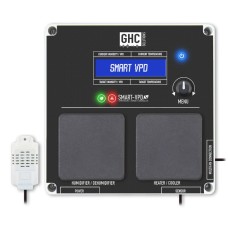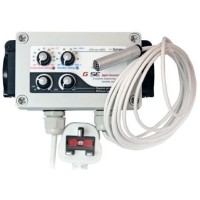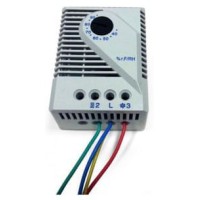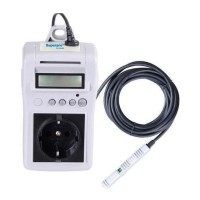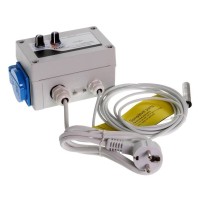GHC Smart VPD Digital Temp / Humidity Controller by GHC Solutions
GHC Smart VPD Digital Temp / Humidity Controller by GHC Solutions
Accessories / Add-ons
-
£269.95
Out Of Stock
SMART-VPD Temp / Humidity Controller
The Smart VPD controls Humidifiers/De-humidifiers & Heaters in the growroom. It optimises ‘Vapour Pressure Deficit’ in order to ensure plants are transpiring at the optimum rate during all stages of growth. Built on AEI technology, the controller will adapt and learn to work with the users individual set-up, taking into account other grow room equipment and their overall effect on the environment. Connects to the Multifan for ultimate grow room environment control!
What is VPD?
VPD (Vapour Pressure Deficit) is an advanced method of measuring the affect your grow-room’s environment has on your plants. Relative humidity (RH) and temperature are the main factors involved in measuring VPD, and as an indoor grower it is important to develop an understanding of what humidity is, how temperature effects humidity and how both of these factors affect our plants.
“Get ready to start thinking the way your plant feels”
Vapour Pressure Deficit is the difference (deficit) between how much water the air can hold when saturated (100% RH) and how much water the air is currently holding. Simply put, this is the difference between the vapour pressure of the air in the grow-room compared with the vapour pressure of the plants leaf. It is the difference between these vapour pressures “The VPD” that dictates rates of transpiration and nutrient uptake. Vapour pressure can be measured in any unit of pressure but is generally expressed in Kilopascals (KPa) or Millibar (Mbar).
Water is used as a coolant by the plant. As it evaporates from the leaf through the stomata (tiny mouth like holes under the leaf) water exits the leaf, taking heat away from the plant. Capillary action transports water and nutrient through the plant from the roots via the xylem vessels (tiny tube-like structures that travel from the roots to leafs). This will replenish water lost from the leaf, similar to the workings of an oil candle, as the flame burns off the oil, capillary action pulls more oil through the wick to replenish that what has just burnt and so on….
Lower humidity in the air will increase the rate of evaporation from the leaf. This capillary action will wick moisture through the plant quicker, resulting in higher rates of transpiration. This is the same hidden force that is responsible for drying your clothes on a washing line. This is known as the drying force of the air. VPD values run opposite to RH, so when RH is low (less moisture in the air) the VPD value is high and vice-versa. The higher the VPD, the greater the drying force of the air!
Measuring VPD is a far more accurate and advanced method of monitoring your grow-room’s environment compared to simply measuring temperature and humidity. If you can manage and control VPD in the grow room, you are essentially able to manage and control the flow of water and nutrients through the plant.
“Once you understand VPD and its effects, you are well on your way to becoming a master of your indoor environment…”
Finding the correct VPD balance throughout your growth stages is crucial! Too low at the wrong time and you can expect to see slow growth, disease, moulds and mildews. Too high at the wrong time and you can expect stressed plants, nutrient deficiencies, PH fluctuations and a significant reduction in photosynthesis. This is often blamed on the nutrient, soil, genetics or some other grow room equipment. Nine times out of ten it is the environment that is responsible for the problem and correcting environmental issues will often solve many problems erroneously blamed on other factors. Get VPD right and expect luscious growth from start to finish, exceptional product quality and large yields!
How does VPD affect my plants?
If the grow room temperatures are too high and/or humidity too low (VPD too high), the transpirational pull applied upon the plant will quickly increase, transporting higher amounts of water and nutrient. The nutrients can quickly build up to toxic levels creating further deficiencies leading to plant health problems. At the same time the growing medium will be drying out at a higher rate creating salt build ups and wider PH fluctuations.
So… What happens if the plant is loosing more water through the leaf than it can replenish through from the roots? That is where the stomata come into play; The stomata are like little valves separating the wet conditions on the inside of the leaf from the usually dryer conditions of the outside air (the grow room or green house). Opening and closing the stomata controls the amount of water vapour, carbon dioxide and oxygen that is able to be transferred back-and-forth.
In the case of the VPD being too high and the plant loosing more water than it can replenish, the stomata will start to close, regulating the amount of water being transpired. If it wasn’t for this regulation by the stomata the plant wouldn’t be able to reduce the amount of water leaving the plant, and it would quickly dry out.
Are your plants surviving, or thriving?
Although plants may still look OK in this case they’re in fact far from it, they’re simply surviving. As the stomata closes to regulate and reduce the water loss it also regulates and reduces the potential exchange of other gases, most importantly CO2. As the access and exposure to CO2 reduces, so does the rate of photosynthesis.
Connect your Smart-VPD and Multifan Controller for Ultimate Control!
Connect the Smart-VPD to your GHC Multifan Controller via the auxiliary port. Take environment control to the next level and manage all aspects of your temperature and humidity.
Pre-Order - Call us for more details: 01483 596 484
Tags: GHC, Smart, VPD, Digital, Temp, Humidity, Controller
Q & A
Be the first to ask a question.

